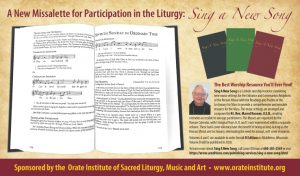 Sing A New Song, published by A-R Editions, Inc. in Middleton, Wisconsin, is a Catholic worship resource combining new music settings for the Entrance and Communion Antiphons of the Roman Missal with the Readings and Psalms of the Lectionary for Mass to provide a comprehensive and reusable resource for the Mass. The music settings are arranged and composed by Right Rev. Abbot Marcel Rooney, O.S.B. (former Abbot Primate and President of the Orate Institute), creating melodies accessible to average parishioners.
Sing A New Song, published by A-R Editions, Inc. in Middleton, Wisconsin, is a Catholic worship resource combining new music settings for the Entrance and Communion Antiphons of the Roman Missal with the Readings and Psalms of the Lectionary for Mass to provide a comprehensive and reusable resource for the Mass. The music settings are arranged and composed by Right Rev. Abbot Marcel Rooney, O.S.B. (former Abbot Primate and President of the Orate Institute), creating melodies accessible to average parishioners.
The masses are organized by the Roman Calendar, with Liturgical Years A, B, and C each represented within a separate volume. These hard-cover volumes have the benefit of being as long-lasting as the Roman Missal and Lectionary, eliminating the need for annual, soft-cover resources. The books include: The Order of Mass; music settings for the Order of Mass; antiphons, readings, and psalms for each Proper Mass; antiphons, readings, and psalms for additional masses; and over 150 selected traditional hymns
There are 4 principles upon which this new work is based:
Theological Principle – The Constitution on the Sacred Liturgy (# 14) stated this: “Mother Church earnestly desires that all the faithful should be led to that full conscious, and active participation in liturgical celebrations which is demanded by the very nature of the liturgy…”
 The General Instruction of the Roman Missal gives directives for the implementation of how we are to do this. We may take as an example, the Entrance Antiphon in the Missal. Since we have generally lacked music appropriate for the singing of this Antiphon (and it is intended to be sung, not merely recited), most liturgical leaders have fallen back on the habit of singing hymns for the Entrance to Holy Mass. The good thing about that practice is that it succeeds oftentimes in involving many of the congregation in this opening element of Holy Mass. But it is not the tradition of the Roman Church. We have always reserved opening various liturgies with hymns to other liturgies, e.g., the Liturgy of the Hours. Holy Mass always had an Antiphon and Psalm for this opening element. This new Missalette is intended to address this lacuna of the last fifty years, and in a way that makes it possible for the largest number of people to participate as we begin Holy Mass.
The General Instruction of the Roman Missal gives directives for the implementation of how we are to do this. We may take as an example, the Entrance Antiphon in the Missal. Since we have generally lacked music appropriate for the singing of this Antiphon (and it is intended to be sung, not merely recited), most liturgical leaders have fallen back on the habit of singing hymns for the Entrance to Holy Mass. The good thing about that practice is that it succeeds oftentimes in involving many of the congregation in this opening element of Holy Mass. But it is not the tradition of the Roman Church. We have always reserved opening various liturgies with hymns to other liturgies, e.g., the Liturgy of the Hours. Holy Mass always had an Antiphon and Psalm for this opening element. This new Missalette is intended to address this lacuna of the last fifty years, and in a way that makes it possible for the largest number of people to participate as we begin Holy Mass.
Musical Principle – The Constitution on the Sacred Liturgy of the 2nd Vatican Council stated this in #116: “The Church acknowledges Gregorian chant as especially suited to the Roman liturgy; therefore, other things being equal, it should be given pride of place in liturgical services.” The Antiphons in the Missalette Sing a New Song are all based in Gregorian chant. The composer has sung the chant for decades and his musical and prayer formation has been affected by the chant very profoundly. The reader will note that each Antiphon even has the number of the Gregorian mode in which it is composed. The author has provided a simple set of melodies embodying the eight ancient modal melodies and it is indicated at the beginning of each Antiphon. The cantors verses will be sung in that mode, then, maintaining the spirit of the Antiphon itself.
Pastoral Principle – As has been stated already in regard to the directives of #48 of the General Instruction of the Roman Missal, the people are to pray and sing the Antiphons provided by the Church. The music composed for the Antiphons in this Missalette embody the belief that the people’s part should be kept to a small part of the original Antiphon, so that they can indeed participate fully. The composer has had the opportunity to try out these Antiphons in typical small town parishes, and with outstanding results, as regards the enthusiastic participation of the people, who pick up the melodies after only one or two repetitions.
Practical Principle – It is a concern for anyone who cares about the environment, that as a normal practice our parishes, taken as a whole, are throwing away every year thousands and thousands of missalettes, and then buying new ones in time for the 1st Sunday of Advent. One of the values of this Missalette is that the Sundays are not dated by the given year’s calendar, but by the liturgical year’s calendar. That means that they can be used over and over again. This Missalette will be published in separate editions for the A-Year, B-Year, and C-Year. That means that the greater part of the expense of the Missalette will be born only in the first three years a community uses them. At the end of the year, the sacristan can box them up and save them for reuse three years later. This will mean a very great saving for budgets, as also a saving of the environment.
To learn more about Sing A New Song, call Lance Ottman at 608-203-2569. Or click here.